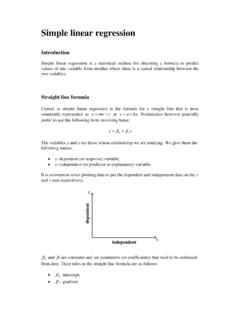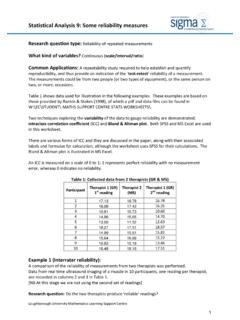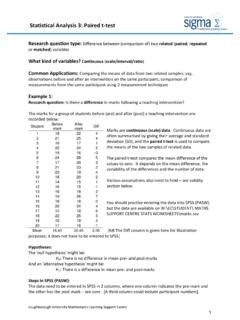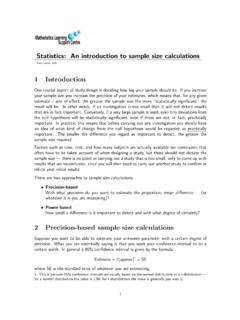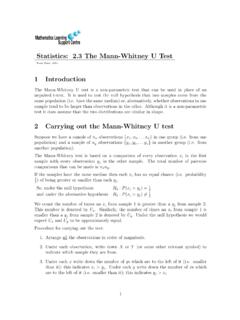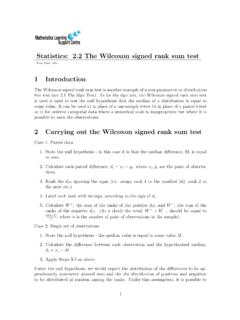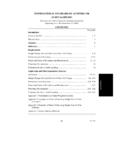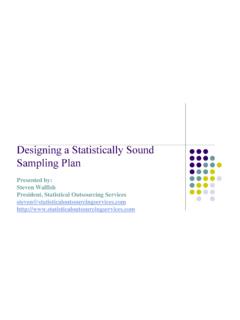Transcription of Statistical Methods 13 Sampling Techniques
1 Community project encouraging academics to share statistics support resources All stcp resources are released under a Creative Commons licence Statistical Methods 13 Sampling Techniques Based on materials provided by Coventry University and Loughborough University under a Na9onal HE STEM Programme Prac9ce Transfer Adopters grant Peter Samuels Reviewer: Ellen Marshall Birmingham City University University of She eld Workshop outline We will consider: q Sampling Techniques : Non-random Random Peter Samuels Reviewer: Ellen Marshall Birmingham City University University of She eld Sample surveys Subjects included in a study can be selected using either: q A non-random Sampling approach, or q A random Sampling approach Peter Samuels Reviewer: Ellen Marshall Birmingham City University University of She eld Non-random Sampling q Types: Self-selecting samples Convenience samples Judgemental samples Quota Sampling .
2 The interviewer has been given quotas to fill from specified subgroups of the population, 20 women 20-30 years old q Can all be very biased q Not representative of population Peter Samuels Reviewer: Ellen Marshall Birmingham City University University of She eld Random Sampling Requires: q Random Sampling method q Random number generation q Sampling frame Peter Samuels Reviewer: Ellen Marshall Birmingham City University University of She eld Random Sampling Methods q Simple Random Sampling : Every member of the population is equally likely to be selected). q Systematic Sampling : Simple Random Sampling in an ordered systematic way, every 100th name in the yellow pages q Stratified Sampling : Population divided into different groups from which we sample randomly q Cluster Sampling : Population is divided into (geographical) clusters - some clusters are chosen at random - within cluster units are chosen with Simple Random Sampling Peter Samuels Reviewer.
3 Ellen Marshall Birmingham City University University of She eld Generating random numbers q Best way is to select numbered balls out of a bag q Or use random number generators Many available online, q Or use Excel: =randbetween(1,200) generates a random number between 1 and 200. Peter Samuels Reviewer: Ellen Marshall Birmingham City University University of She eld Sampling frame q A list of subjects from which a sample of subjects is selected q Examples: Map Census database Employee database Telephone directory q Need to select subjects at random q Without a Sampling frame, random selection is difficult/impossible Peter Samuels Reviewer: Ellen Marshall Birmingham City University University of She eld Example: simple random Sampling q Survey of insect population living in woodland q Trees numbered 1 to 200.
4 Q 10 trees chosen at random Peter Samuels Reviewer: Ellen Marshall Birmingham City University University of She eld Example: Stratified Sampling q Foot measurement study of the population of Taiwan q Total sample size of 1,000. q Sample for each category selected randomly from the population Age Population (000s) Sample Group Male Female Total Male Female Total 0-4 830 772 1602 41 38 79. 5-9 1005 945 1950 50 47 97. 10-14 1016 958 1974 51 48 99. 15-19 929 885 1814 46 44 90. 20-29 1993 1895 3888 99 94 193. 30-49 2744 2635 5379 137 131 268. 50+ 1882 1618 3500 94 80 174. Total 10399 9708 20107 518 482 1000.
5 Peter Samuels Reviewer: Ellen Marshall Birmingham City University University of She eld Example: cluster Sampling q Survey of 1 2 3 4 5 6 7 8 9 10. insect population 11 12 13 14 15 16 17 18 19 20. living in 21 22 23 24 25 26 27 28 29 30. woodland 31 32 33 34 35 36 37 38 39 40. q Squares chosen a 41 42 43 44 45 46 47 48 49 50. random on the 51 52 53 54 55 56 57 58 59 60. grid q Trees lying 61 62 63 64 65 66 67 68 69 70. within the 71 72 73 74 75 76 77 78 79 80. squares chosen until 81 82 83 84 85 86 87 88 89 90. 10 chosen 91 92 93 94 95 96 97 98 99 100. Peter Samuels Reviewer: Ellen Marshall Birmingham City University University of She eld Cluster Sampling v.
6 Stratified Sampling q Cluster Sampling : Cheaper Usually not representative of whole population q Stratified Sampling : Sample more representative Good information on subgroups Peter Samuels Reviewer: Ellen Marshall Birmingham City University University of She eld Recap q Random Sampling reduces bias q Random Sampling requires: A random Sampling method Random number generation A Sampling frame Peter Samuels Reviewer: Ellen Marshall Birmingham City University University of She el

